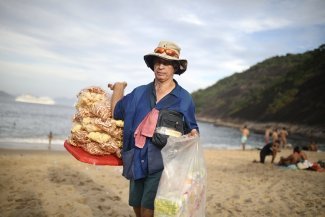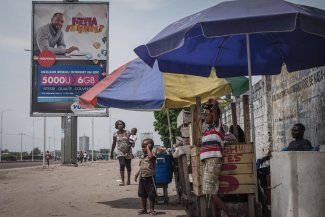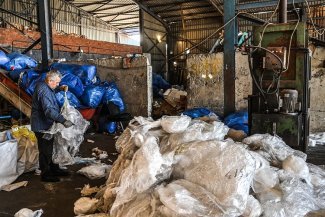Activists from the movement for the protection of Kok-Jaïlaou are fighting for simple, environmentally-friendly leisure activities such as walking through a green landscape, as seen here in February 2019, and against the tourist industry.
Thick hat, ski trousers and walking sticks – in the winter it is difficult to go for a hike in the Kok Zhailau Valley without such equipment. The journey begins 10 kilometres from Almaty, a metropolis in southern Kazakhstan located 1,800 metres above sea level. Koumbel mountain, which overlooks the valley is 3,500, metres high.
At this altitude, your breathing needs to adapt to the fresh air. It is extremely pure, and almost a shock for the inhabitants of Almaty who are no longer used to it. Jamilia, a little brunette in a red jacket, makes frequent stops to wait for her friend. She is doing it to be kind, because she does not seem to get tired: “I don’t come here every weekend, but I try to come as often as possible. In the city, in winter, it’s dark in the morning when you go to work, and when you come back in the evening, it’s already dark again.” For her and her friends, these weekend walks have become an escape from routine and pollution. A thick fog almost completely covers the former capital of the Soviet era, inhabited by nearly two million people.
The snowy slopes behind the giant firs, a dazzling sun and a sky that seems so close – the residents of Almaty could soon be deprived of this oasis of virgin nature. The city plans to build a new ski resort in Kok Zhailau, yet the region already has a dozen. The thousand hectares of the valley would be criss-crossed by 24 ski slopes. The cable cars would take 5,000 visitors a day there, and there are plans to provide them with hotels and restaurants, just like in the best stations in Europe.
There have been plans to build a ski resort in Kok Zhailau for more than 20 years. And there has been controversy over those plans for almost as long. The authorities believe the country’s tourism potential is as yet untapped, and the new resort is seen as a game changer.
The initial project, presented to the government in 2002 by Bonita Engineering, has been changed considerably. Initially the large complex of 84 ski slopes and 43 lifts was to cover an area 3,000 hectares. The cost of the project was estimated at US$1.5 billion. The goal was to attract affluent clients and foreign tourists. Owing to protests by the environmentalists on the one hand, however, and the weakening of the national currency, dependent on the Russian rouble and the price of oil, on the other, expectations had to be lowered.
“Civil society is starting to get suspicious”
Affordable prices, accessibility for people with reduced mobility, open all year – today, the future station is promoted as a social project on a regional scale. It will be less expensive (around US$ 200 million), and the intention is that it will create jobs and make winter sports affordable for young people. But the changes touted by the city and the designers of the project are not enough to reassure many Almaty residents.
“The city’s authorities are trying to show us that they have taken the views of civil society and the experts into account and that the funding has been reduced by a tenth. But that raises an important question: why then can the electricity substation that has been built produce enough power to meet the needs of the old project?
Civil society is starting to get suspicious: will the promise be kept?” wonders Sergey Kuratov, an environmental advocate and president of the Green Salvation organisation. The campaign for the protection of Kok Zhailau has been their main field of action for the last ten years.
“Ile-Alataou [Editor’s Note: The mountain range of which the Kok Zhailau valley is a part] is a key ecological system that ensures the well-being of a very large territory. If the mountain wasn’t here, it would be a desert,” says the specialist. “It gives us a mild climate and plenty of water.”
During the work, hundreds of trees will be cut down, motorways built and an artificial lake created to meet the needs of the complex. According to Akhan Omirbek, an ecologist and one of the authors of the environmental audit commissioned by the Department of Tourism and Foreign Affairs of the city of Almaty, “its impact on the environment will not have significant negative consequences”. But others do not share his view.
Environmental activists fear the worst: the weakening of fauna and flora, water diverted from the city to the resort and an increased risk of mudslides.
Doubts hang over the question of security. “There have always been avalanches there. It is not possible to build, because people can die. There have already been deaths,” says Vladimir Vukolov, director of the Turan University Institute of Tourism, located in Almaty. In the 1970s, this experienced sportsman participated in the search for people killed during an avalanche.
The fact that the valley belonged to the Ilé-Alataou Nature Park meant any activity harmful to its ecosystem could be declared illegal. In 2012, in an open letter, the NGO Green Salvation demanded that construction on the Kok Zhailau site should stop. Two years later, Kok Zhailau was conveniently reclassified as ‘reserve land’ for “the construction and operation of a ski resort”. A legal barrier that prevented its exploitation had been removed.
In central Asia, “we have to fight for tourists”
Since then, environmentalists have been campaigning for Kok Zhailau have its natural park status restored. They attend the public hearings, collect signatures for their petition and organise hikes to make the valley better known.
“The people who support us are not only environmentalists, they are, more generally, people who care about the budget being used properly,” says Svetlana Spatar, another of the NGO’s employees. The funding model has not yet been defined, but the project designers have already mentioned in the press the option of using only public money to begin the construction. If this is the case, it will mean that businesses will only be able to rent commercial premises in the station.
“In total we have collected over 40,000 signatures on the different platforms. On our site alone we have 17,000 signatures. You could say that is not a lot for such a big city but we think that in reality it is a lot because there has never been a public campaign on this scale in our city, or in our country.” The activists are convinced that if they had not campaigned, the construction would already be complete.
Since the country became independent, Kazakhstan’s economy has been based mainly on the export of raw materials, such as oil and gas. The government’s aim now is to diversify, notably by developing tourism. For several years now the authorities have been carrying out an ambitious policy of making tourism more attractive in the country, where for example the Charyn canyon is to be found, often described as a little brother to the Grand Canyon in Arizona.
At the beginning of November Kazakhstan’s Information and Communications Minister, Dauren Abayev announced on the country’s main TV channel that: “We have to fight for the tourists. The mountains we have in the city are a big advantage for Almaty. However, while the construction of a ski resort is still under discussion in Almaty, in our neighbouring countries the ski industry is developing by leaps and bounds.”
At the end of 2018, a new ski station opened in Uzbekistan. Kyrgyzstan and Azerbaijan are also inviting foreign tourists to try out their ski slopes. Faced with this regional competition, environmental protection has visibly stopped being a priority.
To find a compromise with the city authorities, some of the movement’s activists have drawn up an alternative plan for the development of winter sports tourism in the region. They want to revive the ski resorts abandoned since the Soviet era. Reviving these could avoid an environmental disaster in Kok Zhailau and at the same time boost the region’s tourist potential.










